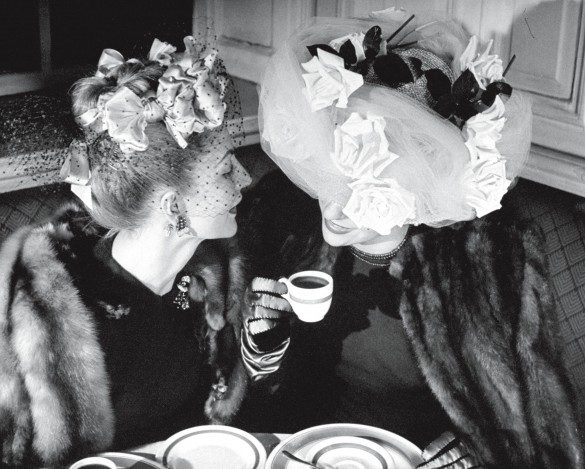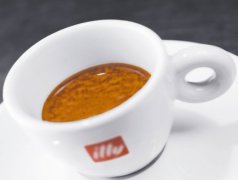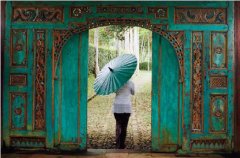Ulysses' coffee.
Core hint: corresponding to the hundred Wine fighting Poems in the East, coffee has also been endowed with the legendary status of "magic medicine" in western literature. Today, Espresso and its derivatives are synonymous with "literary coffee", and the birth of Espresso is closely related to the eastern Italian city of Trieste. Although the celebrity list of cafes here is not as dazzling as that of Rome and Paris, it also has its own pride, and one of the leaders is James Joyce. According to Trieste's travel brochure, Joyce completed "Dubliners" and "Portrait of a Young Artist" here, and the original idea of the masterpiece Ulysses began here.

Well-dressed women in a cafe (pictured in the 1940s)
* Trieste *
With regard to Joyce's preference for coffee taste, the first thing to clarify is that although Joyce is from Ireland, it is almost impossible for him to drink the so-called "Irish coffee". Irish coffee is a mixture of hot coffee, Irish Whiskey and sugar, topped with a thick layer of milk foam. There are many ambiguous legends about the origin of this coffee, the most romantic version of which is that a barista at Shannon Airport in Ireland prepared it for a stewardess he had a crush on. A more realistic version is that on a cold winter night, the barista at the airport bar invented this exciting "coffee cocktail" to appease passengers who missed their flight. No matter which version, Irish coffee was born in the late 1940s, and Joyce died in Zurich in 1941, not to mention that he has not returned to Ireland since 1912.
Joyce first came to Trieste in 1904 and has lived in the city for more than ten years since then. Compared with the history of coffee cooking, you can imagine what kind of choice Joyce would face in a cafe. In 1901, the first commercial coffee machine using steam as a source of pressure was born in Italy. With the development of various related technologies, all kinds of pressurized coffee machines were all the rage in Italy in the 1920s, among which the real concern with Trieste is the Illetta invented by Francisco Italian in 1935. The patent registered at that time called it the first coffee machine pressurized by compressed air. It was based on this coffee machine that Francisco Yili established a coffee kingdom named after him "Illy" in Trieste.
Today Trieste belongs to Italy, but that doesn't mean Joyce tasted the budding Espresso when he lived there. After all, this is Trieste.
Trieste also has a more poetic translation, Tristan, but it seems to have been difficult to promote. The city can be called the miniature stage of centuries of strife on the Istrian Peninsula, and as a port city, it has to bear the extra burden of other historical events: on July 2, 1914, on the road from the port of Trieste to the railway station, a procession of coffins was escorted by the Austro-Hungarian Crown Prince and his wife who had just been assassinated in Sarajevo. Although the name Trieste is a mouthful, it has become a forced memory in most Chinese history books.
Joyce sent a letter from Trieste that the city belonged to "Austria". Like many things that have happened in Trieste, coffee has a crossroads here. Despite many ups and downs, the Habsburg dynasty of Austria was one of the longest to govern the area in modern times. The most splendid buildings in the city date from the Austro-Hungarian Empire. Hungarian-style cafes are famous for their gorgeous interiors, and several old cafes in Trieste continue this style. Traditional Turkish coffee is cooked with spices such as cloves, cardamom and cinnamon, and does not filter the dregs. The top of the brewed coffee is covered with foam, which is actually similar to the Crema on the surface of Espresso coffee. Legend has it that the Austrian picked coffee beans from the Turkish army. To suit the European taste, the first cafe opened in Vienna in 1684 modified it by pouring milk into the black coffee and then spawning variants of varying degrees of milk. One of the most gorgeous versions was the later "cream-coffee-syrup" syllogism of Viennese coffee (Viennese). Viennese Coffee naturally came to Trieste with Austria-Hungary.
The Italian writer Claudio Magris, who was born in Trieste in 1939, lamented in the famous Microcosmi: "the empire no longer exists, but the city is still the same, just like SanMarco." But which one does "empire" refer to? In the same book, Margolis emphasizes that the logo of St. Mark's Cafe is the flying lion of Venice, the symbol of the Principality of Venice at that time. In 1720, Venice opened the first coffee shop in Italy. The port city is no stranger to the practice of mocha coffee (Mocha) from Yemen: lots of cream diluted with cinnamon and cocoa powder. As a result, Italy has a long history of affinity for coffee with heavy milk and sugar flavor. To this day, Italian baristas are still good at playing various coffee-to-milk ratios and word games: "Caffemacchiato" is to add a little hot milk to coffee; "LatteMacchiato" is to add a little coffee to milk. Of course, the cafes of Trieste will not ignore this tradition.

Just three days after Joyce's arrival in Paris, there was a long-rumored story about the cafe: Joyce met with Beech, the owner of Shakespeare's bookstore, at the "Twin even" Cafe in Paris and confirmed the publication of Ulysses.
China Coffee Trading Network: www.gafei.com
Important Notice :
前街咖啡 FrontStreet Coffee has moved to new addredd:
FrontStreet Coffee Address: 315,Donghua East Road,GuangZhou
Tel:020 38364473
- Prev

A glass of technical pie Espresso
Espresso cooked at the ideal temperature is very dark reddish-brown, the foam on the surface will have dark brown spots (Italians call it "el tigre"), and the foam thickness should be more than 4 mm
- Next

Changping Coffee Culture in Southeast Asia
At the beginning of the 20th century, many local cafes were opened in places such as Singapore and Malaysia. In order to integrate into the so-called English civilized world, the rich took Western civilization as the fashion trend. When they gathered in cafes, they accidentally became a culture.
Related
- How did the Salvadoran coffee industry develop in Central America?
- What exactly does the golden cup extraction of coffee mean?
- The Origin of Coffee flower
- [2023 Starbucks World Earth Day] there are more meaningful things besides free Starbucks coffee!
- What kind of coffee is there in Spain? 9 Flavors of Spanish Coffee
- Aromatic African coffee| Kenya's coffee culture and historical production area
- Liberica Coffee Bean knowledge: the characteristics of Liberian Coffee beans of the three original species of Coffee beans
- The origin and formula of Spanish latte introduces the taste characteristics of Bombon coffee in Valencia, Spain.
- How to adjust the solution of over-extracted coffee
- What is the tasting period of coffee beans? What is the period of coffee and beans? How should coffee wake up and raise beans?

